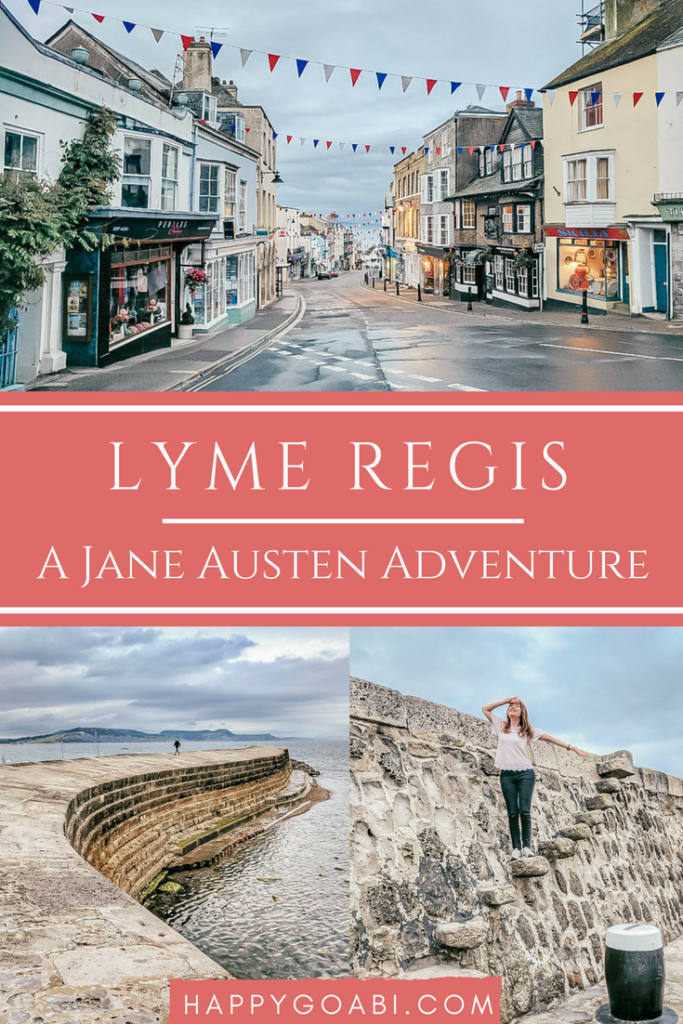Looking for a novel town to visit? You won’t find anywhere better than the town of Lyme Regis.
There are plenty of reasons to visit this cute seaside town…from seeing beautiful scenery, to going fossil hunting, to simply spending a day at the beach.
Yet “The Pearl of Dorset” also attracts visitors because of its connections to Jane Austen and her posthumous novel Persuasion. Want to know how to experience the Lyme Regis of Jane Austen? Read on!

Lyme Regis: A Beautiful Town
Although over 200 years have passed between Persuasion‘s writing and today, the town of Lyme Regis still holds echoes of itself as described by Austen so many years ago.
Austen writes of the “principle street almost hurrying into the water, the walk to the Cobb, skirting round the pleasant little bay…the beautiful line of cliffs stretching out to the east of the town.” And she concludes that it must be “a very strange stranger…who does not see charms in the immediate environs of Lyme, to make him wish to know it better” (Persuasion, Chapter 11).
Just as Austen wrote, the principal street of Lyme still hurries into the water today…and it is a very strange stranger who does not immediately see the charms of this seaside town!
Jane Austen’s Lyme Regis
With gorgeous water, space to stroll, cute beach houses, and darling ammonite street lamps, Lyme is the quintessential holiday town. During Austen’s time, it was similarly (and even more so) a holiday destination.
This town’s fashionable status in the early 19th century drew visitors from around England to its shores. With attractions like the Assembly Rooms, shops, walks and drives, and bathing and cures for invalids, it was always bustling and full during the seaside-going season.
We know for a fact that Austen visited at least twice, once in 1803 and once in 1804, and this place clearly made a great impression on her. Lyme Regis became one of the settings for what would be her final novel, and she quite possibly describes Lyme in the greatest detail of any landscapes in any of her books.

The Cobb: Lyme Regis’ Greatest Landmark
The most dominating landmark in Lyme Regis is certainly the giant, old stone pier called the Cobb. It stretches out into the sea like an alligator’s tale, winding and creating a harbor and promenade-like walkway.
This harbor wall has been around since at least 1328 and has had several incarnations as storms would frequently destroy and damage the wall, but each time it has been rebuilt with a mass of stone to keep protecting the town.
The Cobb was also economically important, as it allowed Lyme Regis to develop as a port and a shipbuilding center (from the 13th century to the 18th century especially). Although Lyme’s importance as a port began to decline after the end of the 18th century, the Cobb’s importance as a landmark for the town remains unchanged.
The Cobb also plays a pivotal role in Austen’s understanding of Lyme and in her novel, as a place where she (and her fictional heroes and heroines) traipsed on holiday.
Like many of her other descriptions of Lyme Regis, Austen’s description of walking on the Cobb still rings true today. Like the walking party in Persuasion, I found that “there was too much wind to make the high part of the new Cobb pleasant” (Chapter 12) and I, similarly to this walking party, opted to take the steps to the Lower Cobb part of the way through my walk.
How to Scare Strangers in Lyme Regis
If you’ve read Persuasion, you’ll likely know that Lyme Regis is most famous among Austen fans because of Louisa Musgrove’s plunge off the steps of the Cobb. You know the plunge. That one that ended in concussion and tragedy when she jumped and Wentworth didn’t catch her. (Oops).

In the name of literature and science (actually, just for my own personal enjoyment) I spent a day wandering the town and recreating Louisa’s scenes, causing only a slight bit of panic in other visitors.
But I guess that’s just what happens when you jump off flights of stairs yelling “Catch me, Captain Wentworth!” and then lay in a heap on the ground.


Fortunately for me (unlike Louisa), I was still very much alive/breathing/conscious after these experiences, and was able to enjoy the rest of the day watching boats and seagulls, going in the water, and eating fish and chips.
And in the end, as an Austen pilgrimage and as a weekend getaway, Lyme Regis transcended my expectations and gave me a new appreciation for both Persuasion and the British seaside.
Save for Later


This post may contain affiliate links. Check out my disclosure to learn more.

I’m reading Persuasion and so appreciate your post. It’s nice to have a quick visit to Jane’s inspiration with a fellow reader.
Hi Judy! I’m so happy to hear you’re a fellow Austen fan! I highly recommend visiting Lyme Regis someday if you get a chance…along with visiting Bath, of course 🙂 It really is so special to get to walk in her steps, and I’m sure you would love it. Enjoy Persuasion!
Delightful post! I plan to visit Lyme for the first time this June.
So fun – you will love it! It’s such an adorable town with a fun literary connection!